The former RAF bomber station at Gaydon on the Banbury Road played a pivotal role in Britain’s defence capabilities during the years of the so-called Cold War in the 1950s and 60s. In April 1959 the Freedom of Royal Leamington Spa was conferred on the station ‘In appreciation of the glorious achievements of the Royal Air Force and as an expression of the esteem in which that force is held by the inhabitants’.
V bombers
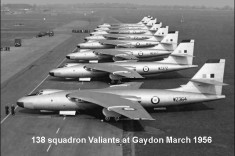 During the 1950s, the British Government invested heavily in a programme to encourage aircraft manufacturers to design and develop a high-level strategic bomber capable of delivering the British nuclear bomb. These so-called V bombers, the Victor, Valiant and Vulcan were fundamentally different from anything that had gone before and in January 1955, No 138 Squadron was formed at Gaydon as the first V bomber squadron, part of No 3 Group Bomber Command. Thus began a new chapter in the Gaydon story.
During the 1950s, the British Government invested heavily in a programme to encourage aircraft manufacturers to design and develop a high-level strategic bomber capable of delivering the British nuclear bomb. These so-called V bombers, the Victor, Valiant and Vulcan were fundamentally different from anything that had gone before and in January 1955, No 138 Squadron was formed at Gaydon as the first V bomber squadron, part of No 3 Group Bomber Command. Thus began a new chapter in the Gaydon story.
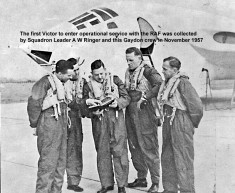 Pilot training on the Valiant and Victor bombers was carried on around the clock, and the noise of these large four-engined jets carried for miles across the flat Warwickshire plain. It was suggested that the ear-splitting noise of the jet engines was endangering the health of people in the villages around Pillerton Hersey at the end of the Gaydon runway. An elderly lady wrote to the Gaydon CO to complain that aircraft vibrations had caused her clock to ‘jump off’ the wall and smash. Ever conscious of maintaining good public relations and in the best traditions of the RAF, the station commander arranged for Gaydon’s skilled instruments mechanics to collect and repair the clock. Station carpenters soon repaired the damaged case and the lady was overjoyed when her rejuvenated clock was returned.
Pilot training on the Valiant and Victor bombers was carried on around the clock, and the noise of these large four-engined jets carried for miles across the flat Warwickshire plain. It was suggested that the ear-splitting noise of the jet engines was endangering the health of people in the villages around Pillerton Hersey at the end of the Gaydon runway. An elderly lady wrote to the Gaydon CO to complain that aircraft vibrations had caused her clock to ‘jump off’ the wall and smash. Ever conscious of maintaining good public relations and in the best traditions of the RAF, the station commander arranged for Gaydon’s skilled instruments mechanics to collect and repair the clock. Station carpenters soon repaired the damaged case and the lady was overjoyed when her rejuvenated clock was returned.
Nuclear bunkers!
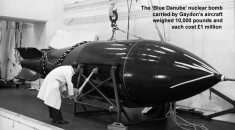 In spite of the high level of security surrounding such a sensitive military installation, people living in that part of south Warwickshire soon became only too aware of the fact that just off the base and close to the Fosse Way, on their doorstep, were several huge bunkers filled with nuclear bombs! What no one knew until much later however was that in the event of war, Gaydon was to be one of the designated dispersal airfields where fully armed V bombers would be stationed
In spite of the high level of security surrounding such a sensitive military installation, people living in that part of south Warwickshire soon became only too aware of the fact that just off the base and close to the Fosse Way, on their doorstep, were several huge bunkers filled with nuclear bombs! What no one knew until much later however was that in the event of war, Gaydon was to be one of the designated dispersal airfields where fully armed V bombers would be stationed 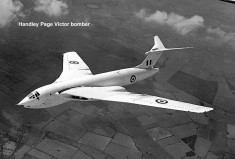 during periods of tension. This of course meant that bases such as Gaydon became primary targets for pre-emptive attack by an enemy. The Cuban missile crisis of 1962 brought the world to the brink of war, and the activities of installations like RAF Gaydon came into sharp focus. The Gaydon aircraft formed part of the Quick Reaction Alert (QRA) force and were fully manned and bombed up ready for immediate take off.
during periods of tension. This of course meant that bases such as Gaydon became primary targets for pre-emptive attack by an enemy. The Cuban missile crisis of 1962 brought the world to the brink of war, and the activities of installations like RAF Gaydon came into sharp focus. The Gaydon aircraft formed part of the Quick Reaction Alert (QRA) force and were fully manned and bombed up ready for immediate take off.
Crash at Combrook
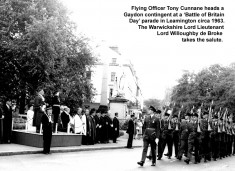 In October 1962 one of Gaydon’s seven Victors, XA934, suffered a serious mechanical failure on take off and crashed in woods at Combrook with the loss of four of the five crew and the complete destruction of the aircraft. The seriously injured co-pilot Flt. Lt. Edward Grinnell was found in a field still strapped into his ejector seat, having ejected at too low an altitude for the proper deployment of his parachute.
In October 1962 one of Gaydon’s seven Victors, XA934, suffered a serious mechanical failure on take off and crashed in woods at Combrook with the loss of four of the five crew and the complete destruction of the aircraft. The seriously injured co-pilot Flt. Lt. Edward Grinnell was found in a field still strapped into his ejector seat, having ejected at too low an altitude for the proper deployment of his parachute.
The 2,500 Gaydon personnel were held in high regard, and developed excellent relations with local towns and villages in the area. The station was one of only two military units to be honoured with the Freedom of Royal Leamington Spa. Each year the incumbent Mayor of Leamington was dined in the Gaydon Officers’ Mess and given a flight in one of the station’s aircraft along with the CO. Each summer the station hosted a superb Open Day which featured static displays of aircraft and a flying display second only to Farnborough. Up to 100,000 people attended each year with the consequent traffic gridlock. One of the items on the programme was a demonstration ‘scramble’ by the station’s Victors (photograph at the top of this page), four of which would be airborne in a minute-and-a-half.
In the next article, I look at the base after the V bombers depart.
I have previously discussed Gaydon’s time as a wartime base, and this can be found here.
Sources/Acknowledgements
RAF Gaydon :An information Handbook for station personnel. Undated but circa 1966
RAF Station Gaydon 1942 – 1945. Privately published by Barry Hope – undated
Royal Air Force Gaydon: A brief history. Published by British Motor Industry Heritage Trust [2001]
Cold War: Building for Nuclear Confrontation 1946 – 1980. English Heritage [2004]
Southam School 25 years. Edited E M Rumary & G A Hayward
Fly Past magazine June 1982
Leamington Spa Courier
Tony Cunnane (Ex RAF Gaydon instructor)
The late Jack Pratley (Wellesbourne)

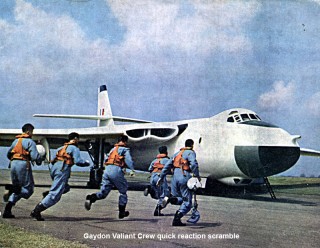






Comments
Hello there, I believe that I was responsible for constructing the first radar scanner under the direction of an American at RAF Gaydon in 1956 when the V-Bombers were stationed there.
While my time at the station was short it was made enjoyable by virtue of the fact that the American, along with his wife, had a caravan on the site where I and my colleague enjoyed a typical American breakfast before we set about our duties.
I was a Senior Aircraftsman at the time. I was with 90 Group and operated from RAF Henlow. I spent three years in the RAF, two of these in Germany stationed at Wahn. I had a fantastic three years and if I lived my life over again I would certainly like to repeat my service days. I did my square bashing at Bridgenorth Shropshire where Johnnie Johnson, one of the Dam Busters was stationed in 1956. If my memory serves me aright I met his wife at our passing out parade. I was an Aerial Erector and it was thanks to this that I eventually gained employment with the then GPO (General Post Office) as a telephone engineer. I ended my 35 year career as a manager.
I‘m now a member of the Arial Erectors site which gives feedback about radio communications.
I was stationed at Gaydon after my photographic training at Wellesbourne 1954. I did a lot of photography of the Valiants, it had a huge bomb bay. During the Suez crisis they were ready to go !! I did a course at Africa House in London as a projectionist and returned to RAF Gaydon to show films of in flight refuelling etc plus the ascent of Hillary climbing Everest to the Officers on Saturday mornings! After having yellow fever jabs in 1955 in case we had to go to “SUEZ” relief! It was all called off. Demobbed in November 1956.
My name is arthur bemrose,I was a s.a.c. Ground electrician at raf Gaydon 1960 to June 1962. Living in kineton I was one of the first on the scene of the victor crash 2-10-62. I was asked to help with the search for the crew, the group I was with found the body of the a.e.o.
Yes, the kite that crashed was one from our squadron. I was on crash crew at the time. The A/C crashed on take off and ended up as a hole on the ground. Myself and a few others were on funeral parade and we did a really very good rifle drill to honour the dead airmen. Something you don’t forget. I was in the Air Force for 12 years and ended up in RAF St Athans.
My parents ran The Swan Hotel, Kineton from 1956. The lounge bar was regularly frequented by officers from RAF Gaydon. No doubt the station benefitted the local businesses.
I was an Air Force brat at RAF Gaydon 1961- 65. My Dad spent most of his time flying the RAF Gaydon Anson. I spent many happy hours in the model club and enjoyed flying my model planes on the airfield at the weekend. One of my memories, of which I have read nowhere else, was waiting for the bus to take me to school in Leamington and seeing that blue Ban the Bomb signs had been sprayed on the Valiants. I live abroad and visited ‘Stokesay Place’ married quarters for the first time in June this year. Very hard to find as it is all so different.
I remember Chris Pinn as he lived over the road from us in Southam Crescent near the large roundabout. He had a, I think, Heineken 3 wheeler that he had to start by using the kick start like an old motorbike. I think his dad was probably the only pilot at Gaydon who wasn’t an officer he was a flight sergeant. I thought this rather odd as I had read that all pilots were all commissioned officers. I asked my dad why wasn’t Mr Pinn one. He didn’t know why.
I am surprised that there aren’t more comments about life at Gaydon because if you take a look at the number of pupils at the school it would be in the region of at least 200. There were 7 classes each with at least 30 in each. I know we had kids from both CAD Kineton and Lighthorne village as neither had primary schools. So someone must have tales to tell about their time there. I’ve got a few but I don’t it to look as if I am taking over.
Add a comment about this page